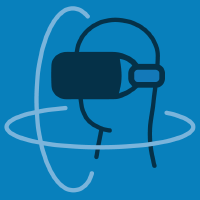Topic Menu
► Topic MenuTopic Editors



Simulations and Applications of Augmented and Virtual Reality

Topic Information
Dear Colleagues,
In recent years, Augmented Reality and Virtual Reality technologies have been at the center of the digital transformation. These technologies have been widely adopted within various domains, such as education, medicine, engineering, architecture, entertainment, art, and culture. With their widespread implementation and availability, the expectation of AR and VR applications have increased, thus establishing opportunities for advanced studies. The Topic Editors encourage the submission of original and mature research studies backed by data and data analytics that discuss the advances of AR, VR, and associated technologies. This Topic is an opportunity for the scientific community to present recent research works associated with augmented and virtual reality.
Topics of interest include but are not limited to:
- AR/VR applications;
- Collaboration through/in AR/VR;
- Artificial intelligence/machine learning using/for/in AR/VR;
- Natural multimodal interaction using/for AR/VR;
- Content creation and management using/for AR/VR;
- Human-computer interactions in AR/VR;
- Perception/presence in AR/VR;
- Education, gamification and entertainment using AR/VR;
- Immersive exergames for health, rehabilitation and wellbeing using AR/VR;
- Production planning and digital manufacturing using AR/VR;
- Cultural heritage and digital art using AR/VR;
- Training using AR/VR;
- Virtual tourism through AR/VR;
- Security issues of AR/VR applications;
- Using AR/VR in e-Commerce;
- Ethics in AR/VR.
Dr. Radu Comes
Prof. Dr. Dorin-Mircea Popovici
Prof. Dr. Calin Gheorghe Dan Neamtu
Prof. Dr. Jing-Jing Fang
Topic Editors
Keywords
-
virtual reality
-
augmented reality
-
multi-modal interaction
-
immersive
-
human-computer interactions
-
user interfaces
-
collaborative distributed virtual environments
-
co-located training mixed environments'
-
educational virtual environments
Participating Journals
| Journal Name | Impact Factor | CiteScore | Launched Year | First Decision (median) | APC |
|---|---|---|---|---|---|

Applied Sciences
|
2.7 | 4.5 | 2011 | 16.9 Days | CHF 2400 |

Computers
|
2.8 | 4.7 | 2012 | 17.7 Days | CHF 1800 |

Electronics
|
2.9 | 4.7 | 2012 | 15.6 Days | CHF 2400 |

Sensors
|
3.9 | 6.8 | 2001 | 17 Days | CHF 2600 |

Virtual Worlds
|
- | - | 2022 | 15.0 days * | CHF 1000 |
* Median value for all MDPI journals in the second half of 2023.

MDPI Topics is cooperating with Preprints.org and has built a direct connection between MDPI journals and Preprints.org. Authors are encouraged to enjoy the benefits by posting a preprint at Preprints.org prior to publication:
- Immediately share your ideas ahead of publication and establish your research priority;
- Protect your idea from being stolen with this time-stamped preprint article;
- Enhance the exposure and impact of your research;
- Receive feedback from your peers in advance;
- Have it indexed in Web of Science (Preprint Citation Index), Google Scholar, Crossref, SHARE, PrePubMed, Scilit and Europe PMC.


